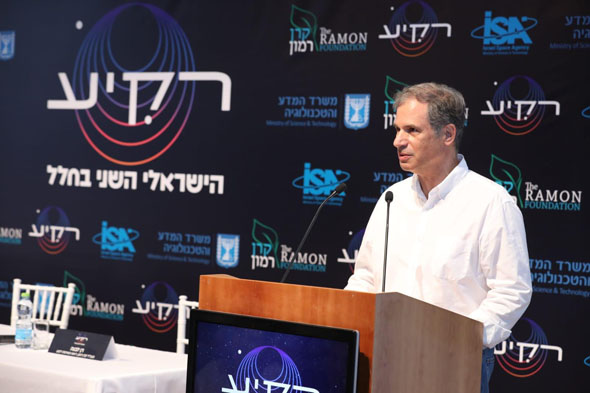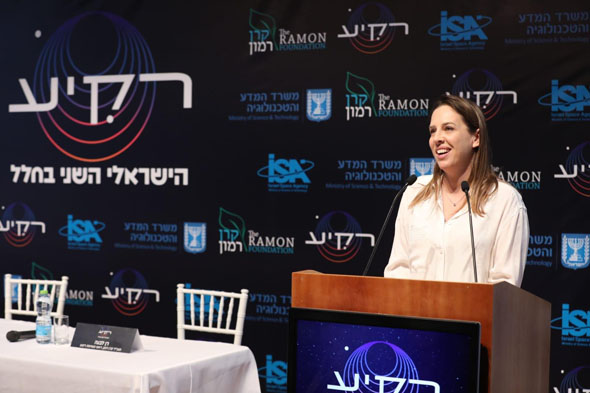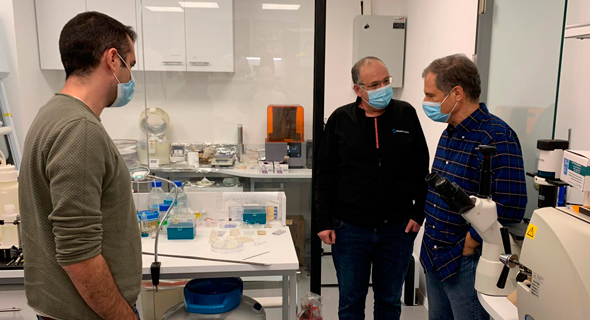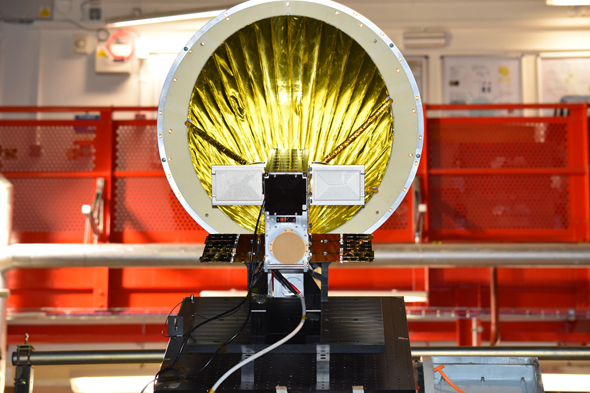Which Israeli technologies will soon be going to space?
Space Hummus, onboard drones, flexible solar panels, and cameras to photograph “lightning elves” are just some of the Israeli technologies that will accompany the next Israeli astronaut to space in 2022
“I’m excited to be here, but I think that it’s particularly exciting for the scientists whose experiments will take the spotlight,” Stibbe told CTech’s Yafit Ovadia. “Israeli technologies will appear on the highest stage in the world that orbits the Earth, where everyone can constantly see them, and I believe that alone is a remarkable achievement.”
 Next Israeli astronaut Eytan Stibbe speaks to the public announcing the experiments he will take with him to the ISS on Wednesday. Photo: PR
Next Israeli astronaut Eytan Stibbe speaks to the public announcing the experiments he will take with him to the ISS on Wednesday. Photo: PR Spigelman related to CTech that she hopes these Israeli experiments and technologies will help spur the local economy as well as growing the space tech ecosystem, and in the future expects to see several space tech venture capital firms as well as startups in Israel. She noted that several government bodies took part in assisting some of these experiments to come to fruition, aside from the Ministry of Science and Technology, including the Ministry of Energy and the Ministry of Health, alongside the Prime Minister’s Office, since some small startups lacked the funding to steer their projects, but with government assistance were able to make the cut.
“Space tech is a significant engine that is steering the Israeli economy, and we believe that the industry will continue to develop over the coming years. Israel is one of the only countries in the world that retains end-to-end capabilities when it comes to building satellites and providing services. The State of Israel clearly has an advantage - based on our military expertise in this sector,” she said. “In the future, this industry could grow by billions of shekels.”
The 44 experiments that Stibbe and his team will take with them to the International Space Station are divided into six subcategories: astrophysics, optics, engineering, medicine, renewable energies, and agriculture. The experiments will accompany Stibbe and his Ax-1 team aboard their SpaceX Dragon capsule although cargo space is limited and the number of experiments has skyrocketed from the proposed 20 to 44. “This mission proves that we have a local Israeli space tech ecosystem here, but we also must lower our expectations, and many risks and challenges await us,” Kreiss said, adding “every university in Israel has taken part somehow in this mission, and it makes me proud to be an Israeli.” The mission is now slated to take off in February 2022.
 Director-General of the Science and Technology Ministry Shai-Lee Spigelman believes the local space tech sector will grow over the next few years. Photo: PR
Director-General of the Science and Technology Ministry Shai-Lee Spigelman believes the local space tech sector will grow over the next few years. Photo: PR Astrophysics
1. Ilan-Es - observing upper-atmospheric lightning
Upper-atmospheric lightning, occasionally referred to as “lightning elves” is a form of electrical-breakdown phenomena that occurs well above the altitudes of normal lightning and storm clouds. The study will examine the structure and behavior of lightning elves, and other atmospheric electrical-discharge phenomena, and is a follow-up experiment to fallen first Israeli Ilan Ramon’s Meidex experiment on his STS-107 mission aboard the Columbia shuttle. Using a camera, astronauts will photograph such phenomena from space, and the information will provide astronauts with advanced warning of lightning storms that inhibit the ISS’s flight path. A team of researchers on Earth will also photograph such occurrences from ground stations. The information from both stations will be compared and analyzed, and grant researchers unique insights, helping them find possible explanations for electrical phenomena in the atmosphere. The project will be led by Prof. Yoav Yair from the Interdisciplinary Center in Herzliya, and partner with researchers at Tel Aviv University, Technical University of Denmark, and Hokkaido University in Japan, and utilize ground Earth stations in Denmark, Japan, Puerto Rico, Hungary, France, Spain, China, the U.S., UK, Brazil, and New Zealand.
2. GALI - Tracking gamma-ray bursts
Gamma rays are a common phenomenon that occur in space, and are intense energetic explosions that have been observed in distant galaxies. They are the brightest and most energetic electromagnetic events known to occur in the universe, and are believed to be emitted by supernovas and blackholes. The experiment examines a prototype developed in a laboratory at the Technion Institute of Technology, headed by Prof. Ehud Bachar, which will include a one-liter sensor that will monitor these eruptions, and be placed outside of the station. An astronaut will monitor signals it receives and transfer it to ground stations for analysis. The project's partners include the Israeli startup MicroGic, which provides products and services in the areas of image processing and recognition algorithms, and Israel Aerospace Industries’ space plant where it designs and builds such equipment.
3. COTS-Capsule - a “safe” in space
The experiment, which is essentially a "safe", will test a patented technology that allows the use of commercial electronics in space using a protective shell or capsule. Using such technology will enable the production of space systems quickly, at low-cost, and high performance. As part of the experiment, an astronaut will place the capsule containing electronic radiation-sensitive components in a designated space inside the station, while analyzing performance and monitoring radiation levels. In addition to the technological demonstrations aboard the station, the experiment will also include a supplementary pedagogical information program for educational institutions. It is being led by Tel Aviv University in collaboration with IAI, the Afeka College of Engineering, and the Herzliya Science Center.
4. Vacuum-Arc Thruster - proof of propulsion using vacuum technology
This experiment is designed to demonstrate a new miniaturized propulsion model based on VAT-Vacuum arc thruster technology, which has been developed in a laboratory at the Technion and commercialized by the Israeli space tech startup Space Plasmatics. The astronaut will record the motions of the model using temperature measurements and energy consumption, adding to trace images. This technology can be used for infrastructure purposes and for maneuvering capabilities of tiny satellites.
5. Astrorad - cosmic radiation vests for astronauts
Israeli startup StemRad, which won a tender from NASA in 2018 to take its cosmic-radiation protection vests, AstroRad, aboard the station, is examining a new generation of its radiation protection suit. The AstroRad vest is a personal protection device that guards astronauts against the high radiation they are exposed to in space, and is efficient and ergonomic. StemRad will collect data for further research to create a wearable vest for longer-range space missions.
Engineering
6. SpacePharma Advanced Lab - a miniaturized laboratory in space
Space Pharma’s miniaturized laboratory is unique, since it conducts experiments in microgravity, where biological and chemical systems have accelerated processes, and scientists can observe three-dimensional growth of cell cultures and molecule structures of proteins and crystals. SpacePharma’s SPAD (SpacePharma Advanced lab) will enable researchers to conduct reliable, repetitive, calibrated and uncalibrated experiments that may be remotely controlled from Earth. SpacePharma will use the results of this experiment to further develop its SPAD version, and explore the functionality of the system and its units.
 Stibbe (right) examines the miniaturized lab he will take with him to space. Photo: SpacePharma
Stibbe (right) examines the miniaturized lab he will take with him to space. Photo: SpacePharma 7. An onboard drone
The drone, developed by TAU’s Prof. Avi Seifert's laboratory can be used as a "personal assistant" for astronauts aboard the space station. The glider will be controlled by a closed-circuit control and equipped with a camera to monitor its efficiency. It will also use artificial intelligence for object recognition and tracking. Using such a device on the space station can help astronauts perform daily experiments, carry tools, photograph, broadcast ground conditions. Proof of propulsion efficiency does not use moving components or fuel, and can expand the use of robots aboard the station. It is being led by TAU with the Yeruham Science Center and IAI.
Optics
8. Microfluidic Lens - creating a lens using a viscous liquid
This experiment involves creating optical components without the need for mechanical polishing. An astronaut will use the system to formulate a lens under microgravity conditions, creating liquid lenses. This will pave the way for the production of advanced optical components in space and create telescopic lenses. The partners on the project include the Technion, NASA Ames Research Center, and MIT.
9. FreeSpace QKD - communication between Earth and space
The experiment will test the transmission of a photon signal from the ISS to an Earth ground station by a receiver that utilizes innovative polarization and algorithmic methods to detect polarized transmissions. The study will send signals and study their receipts, testing and improving optical space communication utilizing quantum encryption capabilities. The project is being led by defense company Elta Systems Ltd., QuanTLR, an Israeli telecommunications company that designs quantum cryptography devices to communicate highly sensitive data; alongside TAU and the Hebrew University of Jerusalem.
10. Nano ISS Antennae - deploying pop-up antennas
NSLComm is an Israeli space tech startup that develops antennas capable of delivering high-bandwidth communications in space. The experiment will deploy an antenna in the station, while a camera will record the course of the deployment as well as its spatial accuracy. The demonstration will help authorize the antenna for satellite use.
 NSLComm's pop-up dish and antennae will also venture to the ISS. Photo: NSLComm
NSLComm's pop-up dish and antennae will also venture to the ISS. Photo: NSLComm 11. Space to Water - two-way communication between space and the ocean
This experiment will demonstrate two-way communication and a combination of underwater acoustics with satellite communication. The astronaut will send orders from the space station to a vehicle located on the seafloor, and receive data and feedback from the water. It is being led by the University of Haifa in collaboration with Gilat Telecom.
Medicine
12. Analyzing bacteria production in space
Bacterial pathogens are the leading cause of foodborne illnesses, and are a common source of infections in humans and animals. Previous studies have shown that growing bacteria in outer space significantly improves their development. This experiment will test the growth of E. Coli and Salmonella bacteria, and use state-of-the-art RNA sequencing techniques to compare growth rate and analyze the genetic expression of the bacteria in space compared to cultures grown in similar ways on Earth. This study will help researchers better understand risks of bacterial diseases in space, and is being led by the Center for Infectious Diseases at Sheba Tel Hashomer and Prof. Ohad Gal-Moore in collaboration with MIT.
13. BBB on a Chip - finding a cure for Alzheimer's disease
BBB, or blood barrier, is a biological marker leading to Alzheimer's disease. This experiment will analyze the effects of microgravity on vascular function in the brain, and potential BBB-targeted drugs which can treat the disease. It has been proven that Alzheimer’s disease advances slower in space, so researchers will attempt to mimic and study how the disease’s progression may be reduced using this method. It is being led by Tel Hashomer.
14. Urinalysis in space
The experiment, led by Healthy.io, an Israeli medical device startup that delivers home urinalysis and digitized wound care, will perform urine tests and analyze the results in real-time of astronauts aboard the station. As space missions become longer and more common, astronauts will need a variety of tools to diagnose and monitor bodily functions, such as urine. Such tests are standard for examining various health conditions including kidney function. The experiment will focus on performing ACR, or the Albumin-to-creatinine ratio to detect elevated proteins and possible kidney malfunctions in real-time.
15. Microbiome in space
This experiment will collect urine samples from astronauts before, during, and after missions to evaluate the microbiome presence in urine using modern methods of genetic sequencing, which will study possible treatments of urinary tract infections that have been known to affect astronauts in the past. The study is a collaboration between Tel Hashomer, the Texas University of Technology, and Thomas Jefferson University.
16. Monitoring stress levels - improving mental resilience in space
This study will examine astronauts’ emotional states using sensors throughout the mission, which will analyze vital signs, sleep physiology, cognitive function, visual and auditory performance, and emotional skills. In addition, the experiment will examine the impact of stressful events and management intervention, and is being led by Tel Hashomer, along with Thomas Jefferson, and Israeli software audio startup Tunefork, which provides improved audio and mobile sound systems.
17. Encephalog - cognitive testing for astronauts using a telephone widget
Israeli medical device startup Mon4t's EncephaLog widget, which is FDA approved, offers medical neurological surveys for monitoring motor and cognitive controls, and performs actions with the help of a smartphone device in real-time. This platform will allow astronauts to test the technology’s feasibility in space for long-term space missions. It is being led by Mon4t, along with the Israel Aerospace Medicine Institute (IAMI) and a German university.
18. Cardiac Ultrasound
This study will focus on performing heart tests in real-time using ultrasound devices aboard the station. Israeli medical device startup, OnSight Medical, will test its technology, where astronauts will perform high quality ultrasound scans with the help and training from a widget in real-time, and receive expert analysis and interpretation. The purpose of the experiment is to gain insights about test cardiac health in space, and expand using such advanced technology in remote locations around the world and in space. IAMI has partnered in the study.
19. Miniature Infusion Device - using IV infusion pumps via remote control
This experiment, led by Israeli medical device startup MedInfuze, will allow for independent intravenous transfusion.The device is powered by a battery and a USB-C connection to connect to a secure medical widget, which will evaluate the efficiency of the operation of the MedInfuze pump system in microgravity, and determine the accuracy of the flow rate. IAMI is also partnering on the study.
20. Ocular Imaging - diagnosing eye issues in space
In this experiment, astronauts will use a real-time sensitive imaging platform for neurological diagnosis, heart rate, and microvascular characteristics placed in front of the eye to process images with algorithms and computerized learning methods for detecting spatial and morphological changes in the eye. Space is quite harmful to human vision, and the risks are abundant, including the dismal phenomenon of “space blindness.” The experiment will examine the effects of spaceflight on physiological changes of astronauts' eyes, and is being led by Tel Hashomer and TAU.
21. Universal red blood cell transfusions
RedC Biotech, is an Israeli pre-clinical development-stage biotech company that is developing a process to produce universal red blood cells for transfusions, which can be suitable for any patient. Its study will examine the use of universal red blood cells in space missions. Human space missions include the need for transfusion of blood. Currently, the guidelines for blood transfusions in space flight require a real-time donation from a crew member. The trial can be provided by medically untrained teams, with no matching issues. It is also partnering with IAMI.
22. Physiological needs of the eye
Medical reports from previous space flights have studied astronauts’ visual function tests, visual acuity (the ability to discern shapes and colors), and retinal function using an Amsler grid. These tests will present a comprehensive picture of how the lack of gravity may affect the visual system, and will be carried out by TAU.
 Medical studies will focus on space's affect on astronaut's vision and the physiology of the eye. Photo: GettyImages
Medical studies will focus on space's affect on astronaut's vision and the physiology of the eye. Photo: GettyImages 23. Eye tracker - monitoring eye activity for effective analysis of nystagmus
Diseases and dizziness caused by microgravity conditions can affect astronauts’ performance. The Israeli Air Force along with IAMI has developed the Tobii Pro EyeSeeCam device, which can detect nystagmus, a vision condition where the eye makes repetitive, uncontrolled movements resulting in reduced vision and depth perception, and affecting balance and coordination. The EyeSeeCam vHI device provides fast and objective measurements of
the vestibular-eye reflex.
24. Monitoring vital signs in space using a clock
While NASA monitors the vital signs of astronauts at all times, currently there isn’t a version of comprehensive mobile monitoring, which includes all 15 essential monitoring cues on a medical clock. Israeli medical device company CardiacSense’s clock contains sensors and parameters that provide measurements such as temperature, respiration rate, blood pressure, oxygen saturation, and continuous heart rate without requiring invasive analysis. The purpose of the experiment is to use the mobile device for health monitoring for astronauts on missions. IAMI partnered on the project.
25. Antiviral T cells - activating immune system to fight viruses
Microgravity conditions weaken the human immune system, and the stimulus signals against pathogens. Tel Hashomer’s study will use pre-stimulated T cells to stimulate the activity of the immune system to help regulate the immune system in space.
26. CRISPR - a genetic diagnosis system for infections in space
CRISPR is a genetic editing method that enables sensitive genetic detection without bulky laboratory equipment or highly skilled personnel. Its reliable molecular detection of DNA sequences can help researchers identify pathogens that may cause astronauts to fall ill, and is being led by TAU, along with the Israel Agricultural Research Organization, and California-based Mammoth Bioscience Inc.
27. Human astrocytes - prolonging life in space
The experiment, led by TAU, will examine the effect of accelerating the aging of human astrocyte cells in space. These brain cells surround neurons and play a vital role in brain activity and metabolism as humans age. According to current research, space causes astronauts to age faster, due to the harsh and grueling conditions. Scientists hope to study these cells, and examine methods for prolonging longevity.
28. Space travel - improving T cells
The experiment examines T cells in space to demonstrate the feasibility of using protein research in biological systems which weaken the human immune system in space. Cell cultures will examine the physiological responses seen when the body is exposed to such extreme conditions, and help preserve and restore astronauts' immune functions leading to longer missions. The study is being led by Tel Hashomer, Jefferson, and Israeli biotech startup Oncohost, which develops personalized strategies to maximize the success of cancer therapies.
29. Studying Creutzfeldt-Jakob Disease
Creutzfeldt-Jakob disease (CJD) is an incurable degenerative brain disease that leads to death within months with rapid deterioration and dementia, and is caused by incorrect folding of a protein. Scientists hope to better study the disease in microgravity, with the CJD Foundation partnering on this project.
30. Improving astronauts’ bone and muscle function
Astronauts face bone and muscle degeneration in long-distance space missions. Israeli startup Amorphical develops and manufactures amorphous calcium carbonate that can help increase bone mass and improve muscle function. The experiment will be tested on SpacePharma’s mobile miniaturized lab platform.
31. Chemotherapy in space
Researchers at the Oncology Department from the Schneider Center for Pediatrics will study leukemia cells under microgravity conditions in the presence of chemotherapy, to investigate the proliferation and response of cells, and further study child chemotherapy, while monitoring changes in RNA.
 Further studies will examine the affect of chemotherapy on human cells in space. Photo: Shutterstock
Further studies will examine the affect of chemotherapy on human cells in space. Photo: Shutterstock 32. Ocular circadian variation - studying blood vessels in eye
Space also has effects on eye anatomy, and researchers postulate that changes may run rampant in pressure within and around the optic nerves. Drainage of blood in the retina and blood layer may also occur. A new imaging method, optical coherence tomography angiography (OCTA) is a non-invasive imaging technique that generates images in a matter of seconds, and can protect astronauts' eyes. The study is being led by the Rabin Medical Center.
33. RetinoSpect45 - observing anatomical changes in eye
Researchers will use a multispectral imaging system to examine the pathological, anatomical, and physiological changes on the optic nerve and retina due to space travel. The device, RetinoSpect45 led by Tel Hashomer, Spring Vision Clinic, and Mayo Clinic will examine those changes.
34. Neurofeedback - improving brain health
Myndlift Ltd., an Israeli Arab startup, uses EEG sensors to measure brain activity and determine a patient's mental state, while presenting training games and videos that are influenced by real-time brain activity. It will perform neurofeedback in remote communication with its sensor platform to improve astronauts' brain health.
35. Neuro-wellness in space
The need to monitor astronauts’ brain activity is ongoing and pertinent. Israeli medical device startup’s patented EEG platform consists of a high-density 500-electrode array with a hassle-free plug and play setup, which combines AI and machine-learning algorithms as well as a virtual-reality environment to study brains. The device attaches automatically to a person’s head, and was developed along with researchers at Ben-Gurion University of the Negev.
36. Reflective eye test
The onset of neuro-ocular syndrome (SANS) has been linked to obesity and a decrease in near-term vision. The experiment, led by researchers at Bar-Ilan University and IAMI aims to investigate the effects of microgravity on visual function. A digital reflective eye examination using a widget will allow a quick and reliable assessment of eye fitness before, during, and after a task.
37. Innovative eyewear for astronauts with beard-vision
Shamir Optical Industry Ltd, which produces high-performance lenses, has come up with an innovative way to treat “beard vision,” where aging eyes are unable to focus at close distances. Shamir’s OverHead PALs lens provides optical enhancement at the bottom of the lens, and allows clearer vision at closer range.
Renewable Energies
38. Li-ion batteries
Silicone is widely used in batteries due to its low cost, and the electrochemical potential it holds. This experiment will demonstrate the assimilation of silicone inside a battery to understand how it functions, and look for solutions for systems with high-energy density. It is being sponsored by the Israel Electric Company and Israeli renewable energy company, StoreDot, which is developing next-generation batteries for electric vehicles.
39. Flexible solar panels
Israeli publicly-traded company Apollo Power (formerly SolarPaint), has created flexible solar panels which can be used in space conditions outside of the space station. The patented solar film technology involves the configuration of bottom electrodes, an exclusive active "solar paint" material, and a plastic membrane. The lightweight flexible panel will be placed outside the station, and data will be collected on electricity generation in terms of efficiency and stability, making transporting, launching, and deploying solar panels far easier. Apollo Power was listed on the Tel Aviv Stock Exchange in 2017 at a NIS 9.4 million ($2.9 million) valuation.
40. Cosmo Cell - generating electricity in space using cosmic radiation
The purpose of the experiment is to stimulate electrons in a conductive medium by using cosmic radiation to generate heat and an electrical current. A ceramic panel with conductive ink consisting of copper particles will be installed outside the station to allow exposure to cosmic radiation. The proposal is a collaboration between IEC and Israeli ink-and-printing company PV Nano Cell, which creates mass-produced inkjet based, printed electronics.
Agtech and footech
41. Cultivated Meat
Israeli foodtech startup Aleph Farms is a leader in the cultured lab-processed meat industry where it uses cow cells to produce meat in a lab, and has previously launched an experiment to space in 2019. Its experiment will test the potential of pluripotent stem cell differentiation of cattle and the formation of muscle tissue embedded in hydrogel, where astronauts will examine the rate of cell division in microgravity, and attempt to grow cow cells for cultured meat in space. Aleph Farms has partnered with SpacePharma, Indian Space Applications Centre, European space agencies, and scientific high tech startup accelerators.
 Aleph Farms' experiment will attempt to grow cow cells to cultured meat in space. Photo: Aleph Farms
Aleph Farms' experiment will attempt to grow cow cells to cultured meat in space. Photo: Aleph Farms 42. Fresh Greens in Space
Israeli agriculture engineering startup GreenOnyx Ltd, which develops fresh greens filled with nutrients and dietary supplements, will grow a water-based lentil plant under microgravity conditions in an autonomous growing facility. The leaves will be tested as food in space, and be produced in a controlled group where their growth rates will be analyzed.
43. Mimicking Martian agriculture
This experiment will attempt to control and analyze crops grown on the space station under environmental growing conditions that imitate the Martian surface. The study will include a habitat that moves on a rotational axis at a fixed speed and gravity that imitates Mars, and include ten plants. Astronauts will monitor their data, including the temperature, light, intensity, duration of illumination, gravity, soil moisture, and growth. The study will join several academic institutions, including the Brenner Regional High School, engineers, remote-sensing experts and physicists from IAI’s Center for Space Innovation, geomorphologists from the Israeli Geological Survey (IGS) and Ben-Gurion University, and plant scientists from the Faculty of Agriculture at the Hebrew University.
44. Space Hummus
Plant life support systems are a strategic component in lunar settlement. Small ecosystems often struggle to stabilize their environment and prevent ecological failure. However, this experiment, led by researchers at Stanford University in collaboration with the Israeli Strauss Group, the D-Mars Analog Center, and the Yeruham Science Center, will use synthetic biology and study plants’ extracellular optogenetics using light in chickpea plants. The tools developed from this study can be used to build and support life on a lunar settlement and beyond. The chickpea, from which the common Israeli dish hummus is made, was chosen for this experiment due to the plant's hardiness and the patriotic connotation it implies.



